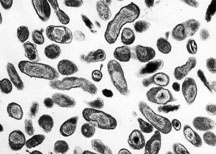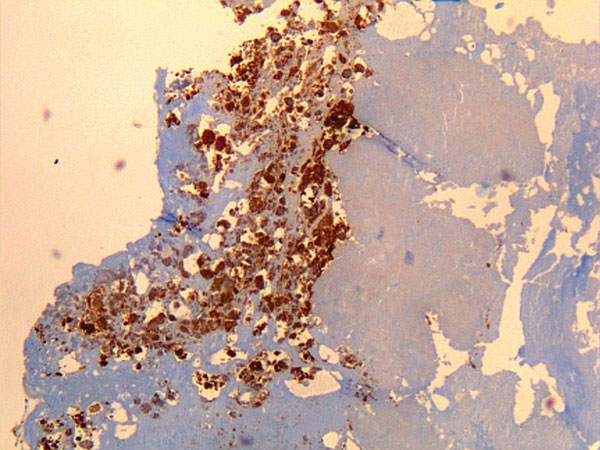Q fever pathophysiology: Difference between revisions
Ahmed Younes (talk | contribs) No edit summary |
Ahmed Younes (talk | contribs) |
||
| Line 1: | Line 1: | ||
__NOTOC__ | __NOTOC__ | ||
{{CMG}} | {{CMG}} | ||
{{Q fever}} | {{Q fever}} | ||
==Overview== | ==Overview== | ||
Q fever is a disease caused by C. brutenii, an intracellular gram-negative proteobacterium. The disease can have a wide range of clinical presentations and affect many organ systems due to the unique virulence factors of the organism. | Q fever is a disease caused by [[Coxiella burnetii|C. brutenii]], an intracellular [[gram-negative]] proteobacterium. The disease can have a wide range of clinical presentations and affect many organ systems due to the unique [[virulence factors]] of the [[organism]]. | ||
==Pathophysiology== | ==Pathophysiology== | ||
| Line 12: | Line 13: | ||
*Vertical (mother to fetus) transmission has been reported | *Vertical (mother to fetus) transmission has been reported | ||
*Parentral | *Parentral | ||
*Through tick bites | *Through [[tick bites]] | ||
===Pathogenesis:=== | ===Pathogenesis:=== | ||
C. Brutenii has the ability to exist in 2 forms: | [[Coxiella burnetii|C. Brutenii]] has the ability to exist in 2 forms: | ||
====Small cell form:<ref name="urlDiagnosis of Q Fever">{{cite web |url=http://jcm.asm.org/content/36/7/1823.short |title=Diagnosis of Q Fever |format= |work= |accessdate=}}</ref>==== | ====Small cell form:<ref name="urlDiagnosis of Q Fever">{{cite web |url=http://jcm.asm.org/content/36/7/1823.short |title=Diagnosis of Q Fever |format= |work= |accessdate=}}</ref>==== | ||
Often described as the spore form of C. Brutenii | Often described as the spore form of [[Coxiella burnetii|C. Brutenii]] | ||
Resists the external environmental factors as heat, pressure and | Resists the external environmental factors as heat, pressure and disinfectants for long periods | ||
====Large cell form:==== | ====Large cell form:==== | ||
The active form of the organism | The active form of the [[organism]] | ||
Large cell form persists in the macrophages inside acidic vacuoles. | Large cell form persists in the [[macrophages]] inside acidic vacuoles. | ||
*Small and large cell forms are antigenically different and this plays a role in the virulence of the organism. | *Small and large cell forms are [[Antigen|antigenically different]] and this plays a role in the [[virulence]] of the [[organism]]. | ||
*The genome of C. Brutenii has been analyzed in 1995. Multiple genes encoding for Na/ ion proton exchanger have been discovered and this explains the ability of the organism to survive in low PH. | *The [[genome]] of [[Coxiella burnetii|C. Brutenii]] has been analyzed in 1995. Multiple [[genes]] encoding for Na/ ion proton exchanger have been discovered and this explains the ability of the organism to survive in [[PH|low PH]]. | ||
The infection has 2 phases that correlate with changes in the lipopolysaccharide of C. Brutenii:<ref name="pmid1489455">{{cite journal |vauthors=Choyce DP |title=Anterior chamber lens exchange |journal=J Cataract Refract Surg |volume=18 |issue=5 |pages=537 |year=1992 |pmid=1489455 |doi= |url=}}</ref> | The infection has 2 phases that correlate with changes in the [[lipopolysaccharide]] of [[Coxiella burnetii|C. Brutenii]]:<ref name="pmid1489455">{{cite journal |vauthors=Choyce DP |title=Anterior chamber lens exchange |journal=J Cataract Refract Surg |volume=18 |issue=5 |pages=537 |year=1992 |pmid=1489455 |doi= |url=}}</ref> | ||
**Phase I: characterized by smooth lipopolysaccharide capsule. Despite being less efficient in the invasion of host cells, antibodies against phase I is always isolated from acute Q fever patients. | **Phase I: characterized by smooth [[lipopolysaccharide]] capsule. Despite being less efficient in the invasion of host cells, [[antibodies]] against phase I is always isolated from acute Q fever patients. | ||
**Phase II: characterized by rough lipopolysaccharide capsule and antibodies against phase II have been isolated from chronic Q fever patients. | **Phase II: characterized by rough [[lipopolysaccharide]] capsule and [[antibodies]] against phase II have been isolated from chronic Q fever patients. | ||
===Q fever as a biological weapon:=== | ===Q fever as a biological weapon:=== | ||
| Line 38: | Line 39: | ||
*Q-fever is category "B" agent. It is highly contagious and very stable in aerosols in a wide range of temperatures. | *Q-fever is category "B" agent. It is highly contagious and very stable in aerosols in a wide range of temperatures. | ||
*Just 1-2 particles are enough to infect an individual. | *Just 1-2 particles are enough to infect an individual. | ||
*Q-fever microorganisms may survive on surfaces up to 60 days (like sporulating bacteria). | *Q-fever [[microorganisms]] may survive on surfaces up to 60 days (like sporulating bacteria). | ||
*According to WHO estimates<ref name="urlapps.who.int">{{cite web |url=http://apps.who.int/iris/bitstream/10665/39444/1/24039.pdf |title=apps.who.int |format= |work= |accessdate=}}</ref>, an amount of 50 kg of C. Brutenii if spread in an area of 2 square kilometers is capable of: | *According to [[WHO]] estimates<ref name="urlapps.who.int">{{cite web |url=http://apps.who.int/iris/bitstream/10665/39444/1/24039.pdf |title=apps.who.int |format= |work= |accessdate=}}</ref>, an amount of 50 kg of [[Coxiella burnetii|C. Brutenii]] if spread in an area of 2 square kilometers is capable of: | ||
:*Infecting 500,000 humans | :*Infecting 500,000 humans | ||
:*Killing 150 individuals | :*Killing 150 individuals | ||
| Line 47: | Line 48: | ||
==Microscopic pathology:== | ==Microscopic pathology:== | ||
*C. Brutenii is a gram negative polymorphic intracellular organism.<ref name="urlQ Fever on JSTOR">{{cite web |url=http://www.jstor.org/stable/4458369?seq=1#page_scan_tab_contents |title=Q Fever on JSTOR |format= |work= |accessdate=}}</ref> | *[[Coxiella burnetii|C. Brutenii]] is a [[gram negative]] polymorphic [[Intracellular|intracellular organism]].<ref name="urlQ Fever on JSTOR">{{cite web |url=http://www.jstor.org/stable/4458369?seq=1#page_scan_tab_contents |title=Q Fever on JSTOR |format= |work= |accessdate=}}</ref> | ||
*It was previously classified as a | *It was previously classified as a [[Rickettsiae|rickettsia]], but now is considered a [[Proteobacteria|proteobacterium]]. | ||
{| class="wikitable" | {| class="wikitable" | ||
![[Image:Q_fever.jpg|center|300px|thumb|Coxiella brutenii ]] | ![[Image:Q_fever.jpg|center|300px|thumb|Coxiella brutenii ]] | ||
| Line 61: | Line 62: | ||
[[Category:Bacterial diseases]] | [[Category:Bacterial diseases]] | ||
{{ Help Menu}} | {{Help Menu}} | ||
{{ Sources}} | {{Sources}} | ||
Revision as of 19:06, 12 June 2017
Editor-In-Chief: C. Michael Gibson, M.S., M.D. [1]
|
Q fever Microchapters |
|
Diagnosis |
|---|
|
Treatment |
|
Case Studies |
|
Q fever pathophysiology On the Web |
|
American Roentgen Ray Society Images of Q fever pathophysiology |
|
Risk calculators and risk factors for Q fever pathophysiology |
Overview
Q fever is a disease caused by C. brutenii, an intracellular gram-negative proteobacterium. The disease can have a wide range of clinical presentations and affect many organ systems due to the unique virulence factors of the organism.
Pathophysiology
Transmission:
The organism is transmitted through:[1]
- Aerosoloes: Inhalation of contaminated aerosoles is the main mode of transmission.
- Ingestion of raw dairy products
- Vertical (mother to fetus) transmission has been reported
- Parentral
- Through tick bites
Pathogenesis:
C. Brutenii has the ability to exist in 2 forms:
Small cell form:[2]
Often described as the spore form of C. Brutenii Resists the external environmental factors as heat, pressure and disinfectants for long periods
Large cell form:
The active form of the organism Large cell form persists in the macrophages inside acidic vacuoles.
- Small and large cell forms are antigenically different and this plays a role in the virulence of the organism.
- The genome of C. Brutenii has been analyzed in 1995. Multiple genes encoding for Na/ ion proton exchanger have been discovered and this explains the ability of the organism to survive in low PH.
The infection has 2 phases that correlate with changes in the lipopolysaccharide of C. Brutenii:[3]
- Phase I: characterized by smooth lipopolysaccharide capsule. Despite being less efficient in the invasion of host cells, antibodies against phase I is always isolated from acute Q fever patients.
- Phase II: characterized by rough lipopolysaccharide capsule and antibodies against phase II have been isolated from chronic Q fever patients.
Q fever as a biological weapon:
- Because of its route of infection it can be used as a biological warfare agent.
- Q-fever is category "B" agent. It is highly contagious and very stable in aerosols in a wide range of temperatures.
- Just 1-2 particles are enough to infect an individual.
- Q-fever microorganisms may survive on surfaces up to 60 days (like sporulating bacteria).
- According to WHO estimates[4], an amount of 50 kg of C. Brutenii if spread in an area of 2 square kilometers is capable of:
- Infecting 500,000 humans
- Killing 150 individuals
- Causing acute illness in 125,000 individuals
- Causing chronic illness in 9,000 individuals
Microscopic pathology:
- C. Brutenii is a gram negative polymorphic intracellular organism.[5]
- It was previously classified as a rickettsia, but now is considered a proteobacterium.
References
- ↑ Marrie TJ (1990). "Q fever - a review". Can. Vet. J. 31 (8): 555–63. PMC 1480833. PMID 17423643.
- ↑ "Diagnosis of Q Fever".
- ↑ Choyce DP (1992). "Anterior chamber lens exchange". J Cataract Refract Surg. 18 (5): 537. PMID 1489455.
- ↑ "apps.who.int" (PDF).
- ↑ "Q Fever on JSTOR".

